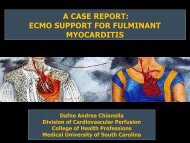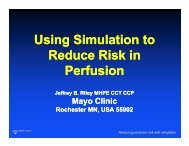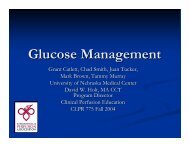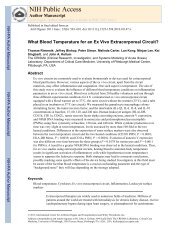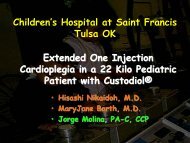Apico-aortic Valve Conduit for Aortic Stenosis and ... - Perfusion.com
Apico-aortic Valve Conduit for Aortic Stenosis and ... - Perfusion.com
Apico-aortic Valve Conduit for Aortic Stenosis and ... - Perfusion.com
Create successful ePaper yourself
Turn your PDF publications into a flip-book with our unique Google optimized e-Paper software.
<strong>Apico</strong>-<strong>aortic</strong> <strong>Valve</strong> <strong>Conduit</strong> <strong>for</strong><br />
<strong>Aortic</strong> <strong>Stenosis</strong> <strong>and</strong> Previous<br />
Coronary Artery Bypass<br />
Dr. Anthony Shackel<strong>for</strong>d DHA, CCP, CCT<br />
Assistant Professor<br />
Cardiovascular <strong>Perfusion</strong> Program<br />
Medical University of South Carolina<br />
Charleston, South Carolina
Preface<br />
2
Am I Nervous?<br />
3
Good to Be Back!<br />
4
Let’s Give an Applause!!<br />
Great Job !!<br />
Florida <strong>Perfusion</strong> Society<br />
Board <strong>and</strong> Members<br />
5
Background<br />
6
<strong>Valve</strong> Surgeries in<br />
United States<br />
• 106,000 valve surgeries per year in United States<br />
• AVR is most <strong>com</strong>mon<br />
• Overall Mortality <strong>for</strong> AVR is 2.6%<br />
• 37% of AVR patients atherosclerosis of ascending<br />
aorta have been reported to have atheroembolic<br />
events vs 2% without atherosclerosis<br />
7
Perfect Storm Developing<br />
• Coronary Artery Bypass Grafting (CABG)<br />
• most <strong>com</strong>mon open heart surgery procedure<br />
per<strong>for</strong>med in the United States<br />
• Average age of population <strong>and</strong> OHS patient is<br />
increasing<br />
• <strong>Aortic</strong> <strong>Stenosis</strong> 4.6% prevalence in people >75y.o.<br />
• subset of CABG population later present with AS<br />
<strong>and</strong> disease of the ascending aorta while still<br />
possessing patent bypass grafts<br />
8
Out<strong>com</strong>es of AVR post CABG<br />
• AVR with CABG patients have as high<br />
as an 18% mortality rate<br />
• Redo-sternotomy<br />
• Potentially have to sacrifice patent grafts<br />
to <strong>com</strong>plete replacement<br />
• Cross-clamping / Cardioplegic Arrest<br />
• Greater # risk factors, etc.<br />
9
Alternatives<br />
• Percutaneous AV<br />
insertion<br />
• Trans apical AVR<br />
• <strong>Apico</strong>-<strong>aortic</strong> valve<br />
conduit<br />
Image: Gammie, J. S. et al. Circulation 2008;118:1460-1466<br />
10
Case Report<br />
11
Patient Background<br />
• A 64 year old Caucasian Male<br />
• Medal of Honor recipient<br />
• 74 kg<br />
• 157 cm<br />
• 1.76m 2<br />
12
Cardiac Risk Factors<br />
• Hypertension<br />
• Hyperlipidemia<br />
• CAD<br />
• Chronic renal<br />
insufficiency<br />
• (creatinine 3.1)<br />
• Diastolic congestive<br />
heart failure<br />
• Type II diabetes<br />
mellitus<br />
13
Clinical Presentation<br />
• Severe shortness of breath<br />
• Dyspnea on exertion<br />
• Angina <strong>and</strong> non-ST segment elevation<br />
myocardial infarction<br />
14
Interventional History<br />
• CABG x 5<br />
• 1996<br />
• SVG PCI<br />
• 2005<br />
• 2006<br />
• 2008<br />
• (7 Stents total)<br />
15
Cardiac Catherization Report<br />
• Patent LIMA -> LAD<br />
• Patent SVG -> PDA<br />
• EF = 50-55%<br />
• Severe <strong>Aortic</strong> <strong>Stenosis</strong><br />
• VA = 0.9cm 2<br />
• Gradient 41mmHg<br />
• Hypokinesis<br />
• Inf. Post. LV walls<br />
16
Laboratory Values<br />
• Hgb =11.3gm/dL<br />
• Hct = 33.8%<br />
• Plt = 280,000/mm 3<br />
• Fibrinogen 200 mg/dL<br />
• WBC 11,300/µL<br />
• Na = 134 mEq/L<br />
• K = 4.9 mEq/L<br />
• Cl = 97 mEq/L<br />
• Glucose = 246 mg/dL<br />
• Cr = 3.05 mg/dL.<br />
• Pt = 13.2 s<br />
• Ptt = 34.2 s<br />
17
Surgical Plan<br />
• Given patency of<br />
grafts <strong>and</strong> overall<br />
condition of patient<br />
coventional AVR<br />
was not advised<br />
• Insertion of an<br />
apico-<strong>aortic</strong> valve<br />
conduit using<br />
cardiopulmonary<br />
bypass<br />
18
Components of Apical <strong>Valve</strong> <strong>Conduit</strong><br />
Medtronic Freestyle Porcine <strong>Valve</strong><br />
Hancock 16mm LV connector<br />
18 mm Gelweave Branched Graft
Extracorporeal<br />
Equipment <strong>and</strong> Circuit<br />
• HL Machine<br />
• Terumo Advanced<br />
<strong>Perfusion</strong> System 1<br />
• arterial roller pump<br />
• Extracorporeal<br />
Circuit<br />
• Terumo X-coating<br />
• 3/8” Arterial Line<br />
• ½” Venous Line<br />
• Capiox SX-25 oxygenator<br />
• open venous reservoir<br />
• Capiox arterial line filter<br />
• Priming Volume 1500cc<br />
• Vacuum Assisted<br />
Venous Drainage<br />
• 27fr Femoral<br />
Venous Cannula<br />
• 7.0mm straight<br />
<strong>Aortic</strong> Cannula<br />
20
Conduct of <strong>Perfusion</strong><br />
Plan <strong>and</strong> Details<br />
• Complete Cardiopulmonary Support<br />
• CI 2.4 – 2.8 L/min/m 2<br />
• No cardioplegia<br />
• ACT > 480s<br />
• (Initial Bolus: 400IU/kg)<br />
• MAP >70 mmHg<br />
• CVP = Low!<br />
• Normothermia<br />
• VAVD = -40 mmHg<br />
• Femoral Venous Cannulation<br />
21
Surgical Sequence<br />
• Prepare <strong>Valve</strong> <strong>Conduit</strong><br />
• Hancock 16mm LV<br />
connector<br />
• Medtronic Freestyle<br />
19mm porcine valve<br />
• Left Lat. Thoracotomy<br />
• Systemically Heparinize<br />
• Attach 18mm x 40mm<br />
Gelweave Branched Graft to<br />
descending aorta using<br />
partial occluding clamp<br />
• Insert 27fr Femoral Venous<br />
Cannula<br />
• Insert 7.0 mm straight<br />
cannula in side branch of<br />
Gelweave graft.<br />
• Initiate CPB with VVAD<br />
• Core LV <strong>and</strong> place LV<br />
Connector with <strong>Valve</strong><br />
• Anastomose <strong>Conduit</strong> to<br />
Gelweave Graft (de-air)<br />
• Terminate CPB<br />
22
<strong>Perfusion</strong> Out<strong>com</strong>e<br />
• All perfusion objectives were met<br />
throughout bypass run<br />
• 2 units washed PRBC administered<br />
• Not able to RAP<br />
• Bypass run was 52”<br />
• Uneventful course<br />
• Uneventful weaning<br />
23
Patient Discharge Summary<br />
• Extubated post-operative day 1<br />
• Experienced bout of hyperglycemia<br />
• Had eleveated white blood cell count<br />
• Cultures negative<br />
• Trending down / afebrile<br />
• Physical exam revealed no signs of infection<br />
• Discharged post-operative day 13<br />
24
Readmission & Follow-up<br />
• 4 days later <strong>for</strong> CHF<br />
• EF 40%<br />
• Mild mitral regurgitation<br />
• **Cr. = 2.5<br />
• Intubated next day<br />
• Possible aspiration pneumonia<br />
• 6 days on vent<br />
• CPAP – “really helps”<br />
• Discharged day15<br />
• 4 week follow up patient states energy is goodmild<br />
DOE, denies CP, orthopnea, PND or lower extremity<br />
edema<br />
25
Discussion<br />
The Future<br />
26
Future Surgical Volumes<br />
• CABG has been the mainstay of Open Heart Surgery<br />
• CABG Volumes are eroding<br />
• Baby Boomers are offsetting this<br />
• OHS is indicated <strong>for</strong> MVCAD<br />
• Patients are getting older<br />
• With age <strong>com</strong>es greater CAD <strong>and</strong> valve<br />
dysfunction<br />
• Bottom Line: More challenging patients are <strong>com</strong>ing!<br />
27
Harbinger of the Future?<br />
• Some centers are doing this procedure<br />
without CPB<br />
• Yet perfusionists still need to be there <strong>and</strong><br />
prepared to execute the techniques <strong>and</strong><br />
adjunct procedures such as those seen in<br />
this case<br />
• Be prepared to take CPB further<br />
28
Is there an opportunity?<br />
29
If we improve they will <strong>com</strong>e!<br />
• The hemodynamic stability that CPB<br />
provides is still attractive to surgeons<br />
• Consider OPCAB v PADCAB scenario<br />
• The reserviorless mini-circuit may be the<br />
key <strong>for</strong> optimum out<strong>com</strong>es<br />
• Consider this case with respect to blood usage<br />
• Bottom Line: Improve <strong>and</strong> use all tools!<br />
30
Answering the Call<br />
• Consider we have<br />
<strong>com</strong>e full circle in 50<br />
years!<br />
• The next level is here<br />
• Are perfusionists <strong>and</strong><br />
manufacturers going<br />
to answer the call?<br />
31
Conclusion / Re<strong>com</strong>mendations<br />
• This is a report of a successful case of an<br />
AAVC using CPB as a surgical alternative to<br />
the st<strong>and</strong>ard AVR <strong>for</strong> patients with AS <strong>and</strong><br />
previous CABG.<br />
• It is re<strong>com</strong>mended the perfusionist be<strong>com</strong>e<br />
familiar with this alternative <strong>and</strong> make<br />
adjustments <strong>for</strong> the nuances this technique<br />
requires with respect to the conduct of CPB.<br />
32
Questions / Discussion<br />
33
Thank You<br />
34



